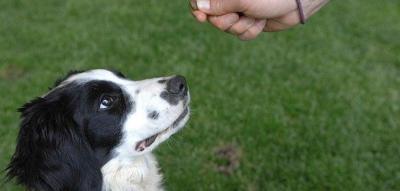
How to Teach a Dog to 'Leave It'
Like teaching dogs “stay,” teaching dogs to "leave it” might prevent them from being injured or even save their life. Hazards that you want your dog to leave alone include toxic foods and chemicals, broken glass, or even another animal. Your dog responding to the cue “leave it” can be the difference between you giving quick praise or heading to an emergency vet clinic.
Teaching a dog 'leave it'
Here are the steps to teach “leave it”:
- Start with two types of treats — one high value and the other something not as exciting.
- Place the lower-value treat on a flat surface, and cover it with your hand. If you like to train with a clicker as your marker, have that in your other hand.
- Allow your dog to approach and sniff your hand that is covering the treat.
- Say “leave it,” and wait until your dog finishes sniffing your hand.
- As soon as your dog is done sniffing, you can either click with the clicker or say “yes” and immediately give them the high-value treat.
- Repeat until your dog immediately stops sniffing your hand when you say “leave it.”
- Once your dog has learned to stop sniffing your hand right away when you say “leave it,” leash your dog and then toss a lower-value treat outside of their reach.
- Wait until your dog stops sniffing and pulling toward the treat. As soon as they do this, either say “yes” or click, and then give your dog a high-value treat from your hand.
Practice this exercise several times. Over time, your dog should stop pulling as soon as you give the cue.
When rewarding with a treat, make sure it is something good, not plain old kibble. You are teaching your dog that leaving some food doesn’t mean they won’t get anything, but rather they might get something even more delicious.
Home starts with you
Expanding the meaning of the cue
Once your dog is reliably responding to the cue, you can teach that “leave it” can apply to other things as well, not just food. Repeat the exercise with five different items that are fairly boring to your dog.
After using five different “boring” items, start using slightly more exciting items. You know your dog, so you know which items they would consider more interesting. Just don’t jump to high-value items right away.
To increase your dog's chances of success at learning the cue, work up to high-value items gradually. If Kleenex or a piece of plastic, for instance, would instantly attract your dog, don’t start with those. Choose the items based on your ultimate goal: Anytime you cue “leave it,” you want to be confident that your dog will indeed leave whatever you are asking them to leave.
Keep it fun
Change up the reward your dog receives for leaving an item alone. If your dog has a favorite toy, squeak it and play for a moment when they leave the other item of interest. Most dogs love interacting their people, so a moment of praise or play with a toy can be just as effective as a treat.
Moreover, even though you’re practicing “leave it” to keep your dog safe, you want your dog to see it as a fun game you play. Once your dog is proficient at the game in your home, start practicing in a variety of locations with more distractions. Keep sessions short, and let your dog have a break if you see they’re losing their focus.
